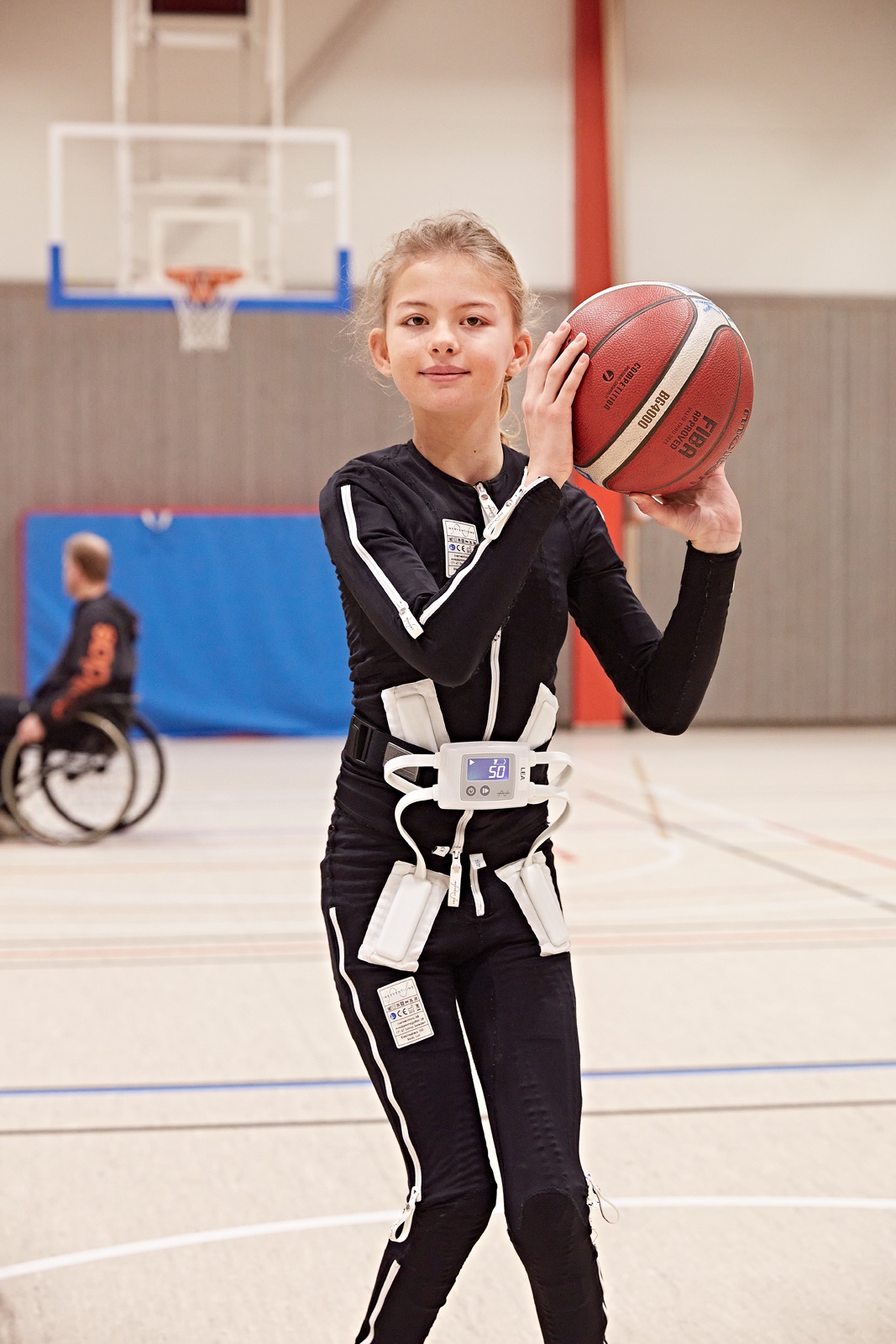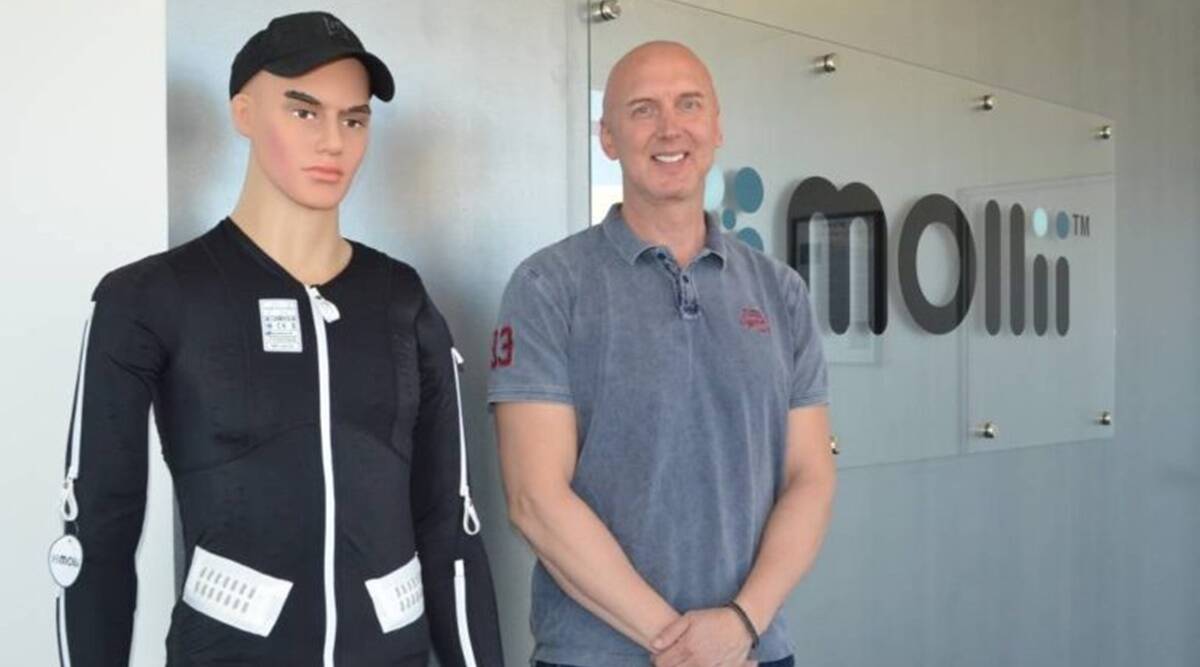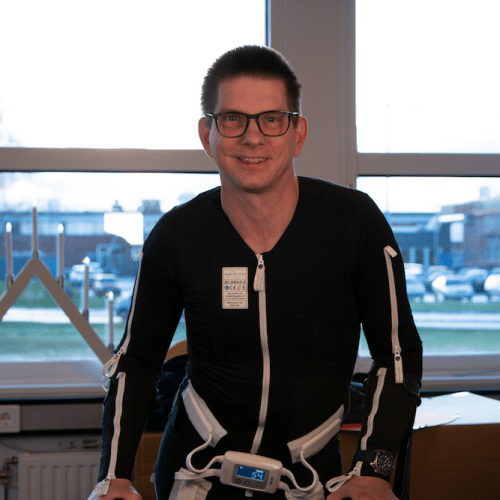A Special Suit That Helps Patients With Parkinson’s
Exopulse Mollii can improve mobility in people with brain or Parkinson’s disease. The suit is equipped with 58 built-in electrodes, which are adapted by a technician to the individual needs of the user. Low-frequency electrical stimulation improves blood circulation and restores previously disturbed balance between muscle pairs. If for example the biceps are tense, the suit stimulates the triceps muscles, which in turn cause the biceps to relax.
Evaluation Of The Application Of The Exopulse Mollii Method Every Second Day
The analysis of the potential fluctuations in spasticity over time did not show any statistically significant difference in NC and NeuroFlexor total resistance before stimulation between day 1, 2, and 3, neither in the upper or lower extremity. These results suggest stable spasticity over days and the lack of any carry-over effect of EXOPULSE Mollii stimulation between time points, a prerequisite for the study of changes in spasticity during and after each session of treatment. These results are in agreement with the short-lasting duration of the effects of a standardized application of EXOPULSE Mollii of up to 48 h, as stated by the company and similarly to the transitory effects of TENS .
How Can An Electrode Suit Treat Nerve Disorders
More than 5 million Americans suffer traumatic brain injury and its side effects every year — side effects that often include neuromuscular problems. More than 760,000 additional Americans are affected by a neuromuscular condition caused by stroke or spinal cord injury every year. And when you add in the number of people living with cerebral palsy and Parkinson’s disease the numbers just keep climbing — it’s estimated that movement disorders affect about one out of seven Americans .
Movement disorders are characterized by a problem with — you guessed it — movement. These conditions impair voluntary and involuntary muscle movements, which translates into problems with things you may take for granted, such as walking and speech. In addition, they may also cause pain, jerky movements and abnormal postures — and conditions that impair people in this way can make living our daily lives difficult.
Treatments often include physical, occupational and other rehabilitative therapies, pharmacotherapy including immunosuppressive drugs, chemodenervation and neurolysis , and sometimes neurosurgery and other therapeutic options. Sometimes patients are treated with electrical stimulation therapy techniques.
EMS works because your body is electric — this type of electrical pulse stands in for how the body’s central nervous system would act if it were properly functioning.
Read Also: Treating Hallucinations In Parkinson’s Disease
Evaluation Of Baseline Spasticity In The Lower Extremity Every Second Day
In the lower extremity of the sub sample, NC before stimulation decreased from day 1 to 2 , but increased at day 3 . As for the upper extremity, the rmANOVA determined that NC before stimulation did not differ significantly between time points in the lower limb . A slight decrease of the NeuroFlexor total resistance was seen over time , but this was not statistically significant .
Discover Other Projects Like Exopulse

Since 2015, Maker Faire Rome has been running a contest dedicated to advanced tech-enabled healthcare solution: Make to Care.
Make to Care is promoted by Sanofi Genzyme, Specialty Care division of Sanofi. Sanofi Genzyme is specifically providing solutions for rare diseases, multiple sclerosis, oncology and immunology. MaketoCare wants to celebrate and support initiatives and projects arising from the cleverness and passion of the Maker community.
Make to Care is aimed at bringing out and facilitating the creation and growth of innovative and useful solutions to meet the real needs of people with any form of disability, meant as any marked decrease in quality of life due to pathologies and / or traumatic events.
The participation to the contest is open to all those who have been able to grasp a concrete need, directing their talent and proposing an innovative solution.
Maker Faire Rome The European Edition has been committed since eight editions to make innovation accessible and usable to all, with the aim of not leaving anyone behind. Its blog is always updated and full of opportunities and inspiration for makers, makers, startups, SMEs and all the curious ones who wish to enrich their knowledge and expand their business, in Italy and abroad.
Follow us, subscribe to our newsletter: we promise to let just the right content for you to reach your inbox
Don’t Miss: What Age Is Parkinson’s Disease Diagnosed
How Does Dbs Work
In DBS surgery, electrodes are inserted into a targeted area of the brain, using MRI and, at times, recordings of brain cell activity during the procedure. A second procedure is performed to implant an impulse generator battery , which is similar to a heart pacemaker and approximately the size of a stopwatch.
The IPG is placed under the collarbone or in the abdomen and delivers an electrical stimulation to targeted areas in the brain that control movement. Those who undergo DBS surgery are given a controller to turn the device on or off and review basic parameters such as battery life.
What Is The Prognosis
Although most people still need to take medication after undergoing DBS, many people experience considerable reduction of their PD symptoms and can greatly reduce their medications. The amount of reduction varies from person to person. The reduction in dose of medication can lead to decreased risk of side effects such as dyskinesia.
There is a 1 to 3% chance of infection, stroke, bleeding in the brain, or other complications associated with anesthesia. It is best to discuss associated risks with your neurologist and neurosurgeon, as diabetes and heart and lung conditions all may influence these risks and the decision to pursue surgery.
Recommended Reading: Signs And Symptoms Of Parkinson’s Disease Dementia
Has The Suit Been Evaluated In Any Clinical Studies
The Suits effectiveness has been evaluated in several different clinical research programs, including both independent and Ottobock-sponsored studies. If youd like to learn more about the results of these studies, please submit the form below to be contacted by the appropriate Ottobock representative.
Data Collection And Outcomes
A physiotherapist and a medical doctor blinded to the frequency of stimulation conducted the assessments before, during, and after each intervention session at day 1, 2, and 3.
Data regarding age, gender, independence in walking , and independence in mobility and personal care were collected. In addition, information about stroke type , time to inclusion from stroke onset and paretic side were obtained. Sensorimotor function including voluntary and passive movement, tactile sensibility to light touch and proprioception and pain were rated according to the FuglMeyer scale for upper and lower extremity , yielding a maximum of 126 and 86 points, respectively, where a lower score indicates more severe impairment .
Measure of Spasticity
Changes in spasticity during and after the use of the EXOPULSE Mollii suit represented the main outcome and were investigated with the NeuroFlexor hand and foot modules. Additionally, surface electromyography was used to evaluate reflex muscle activity in the spastic muscles in the upper and lower limb.
Additional Clinical Measure
Although spasticity is neural in origin, concomitant changes in the soft tissue occur generally after stroke. Thus, limitation in joint movement is an important component of evaluation. Passive and active range of motion of wrist and ankle were measured by the use of a goniometer before and after stimulation, and a change in ROM measurements > 5° was considered clinically significant .
Recommended Reading: Physical Symptoms Of Parkinson’s Disease
Watch How The Suit Puts Lives Back In Motion*
With a simple, non-invasive, drug-free way to manage their spasticity, Louisa and Michele are rediscovering lifes possibilities. See how the Suit turns the bodys natural signals into bodies that move more freely.
Its like I can breathe again.
With the help of her Exopulse Mollii Suit Louisa was finally able to break free from her MS-related spasticity symptoms. Her new superpower: Feeling like everythings possible again.
Frequently Asked Questions About Mollii
Who is EXOPULSE Mollii Suit for?
EXOPULSE Mollii Suit is an assistive device for all ages of people with muscle pain, spasticity and other forms of motor impairment due to CP, MS, stroke, other brain injuries, fibromyalgia or other pain syndromes.
How does the EXOPULSE Mollii Suit work?
EXOPULSE Mollii Suit is a functional garment that consists of a pair of trousers, a jacket and a detachable control unit which sends electrical signals to the user via 58 electrodes on the inside of the garment. The EXOPULSE Mollii Control Unit is individually programmed for each user by combining the electrodes in various ways. The health care professional prescribing the suit uses a computer program to adapt the active electrodes and the intensity . The settings are then saved in the EXOPULSE Mollii Control Unit, making it simple for the device to be used at home.
What happens in the body when EXOPULSE Mollii Suit is used?
What sizes are available for the EXOPULSE Mollii Suit?
The suit is available in 37 sizes, for children, women and mens sizes. Children : 104, 110, 116, 122, 128, 134, 140, 146, 152. Women: XS, S, M, L, XL, XXL, 3XL, 4XL, 5XL. Men: XS, S, M, L, XL, XXL, 3XL, 4XL, 5XL. Unisex: XL Short
Is EXOPULSE Mollii Suit user-friendly?
How often should EXOPULSE Mollii Suit be used?
EXOPULSE Mollii Suit safety
What is included with EXOPULSE Mollii Suit
Supplied with: Jacket, trousers, control unit , belt, laundry bags and user manual.
EXOPULSE Mollii Suit washing instructions
Also Check: Medications To Treat Parkinson’s Disease
Exopulsemollii Suit For Parkinsons Disease
Several health conditions may cause chronic pain and limited mobility because of spasticity. One of the better-known examples of this is Parkinsons Disease, which causes the patient to shake uncontrollably and worsen as time passes. The Exopulse Mollii suit is clothing that stimulates muscles with electrostimulation to help return control over the body to the user.
Can I Keep Using Other Treatments

In most cases, yes, but always consult your doctor to ensure that this is appropriate for you or your loved one. With your doctors approval, the Exopulse Mollii Suit should ideally be used in combination with physiotherapy, training, or physical activity. Discuss the Suit with your doctor if you or your loved one are currently receiving botulinum toxin injections or have been prescribed oral medication for spasticity. Do not use the Suit if you or your loved one have an implanted medical device .
You May Like: Boxing And Parkinson’s Disease
Swedish Inventors Build A Suit That Reduces Spasms
Mollii is the name of the invention that helps people affected by, among other things, Parkinson’s or stroke to move better. The suit works by stimulating the body with electrical signals.
The Swedish invention Exopulse Mollii Suit is an aid for people with spasticity and other forms of motor impairment that can be due to cerebral palsy, stroke, brain damage, spinal cord injury or other neurological injuries. It can also be used to relieve chronic pain.
Mollii is a so-called functional garment. It consists of a pair of trousers, a jacket and a detachable control unit that sends electrical signals to the user via electrodes on the inside of the garment.
The suit has 58 electrodes that can be combined in different ways and a control unit that is individually programmed for each user. The computer program, which is used to program the suit, can adjust the active electrodes, the intensity and which muscles are to be activated with current, and according to the manufacturer it should be easy to use the device at home.
Special Suit Shows How Parkinsons Disease Feels
If you read about Parkinsons disease , you will quickly hear about typical symptom such as muscle stiffness and tremor. But how does that feel?
For a healthy person it is very difficult to imagine who it feels to have PD. Dr Roland Schöffel from SD& C has therefore built the Parkinsons Suit, with which one can simulate PD. The NCER-PD Team has tested the suit at the Annual Conference 2015 of the young patient organisation Jung und Parkinson in Saarlouis, Germany.
At first sight the suits resembles a racing outfit. A young man helps interested people into the red overall. But after the comfortable suit follows quickly the mobility-restricting measures: cuffs on knees and elbows hinder the flexion of these joints. Next follow heavy weights on arms, legs and trunk. The SD& C employee loads a total of 10 kilos onto the participants body and explains that the cuffs and weights should simulate how heavy and inflexible the muscles of patients can feel. The suit focuses only on the motor symptoms and simulates an average person as the severity and type of symptoms can vary from patient to patient. In the practical test, NCER-PD employee Dr Sabine Mosch is clearly walking slower. She clearly has a hard time pursuing movements that require lifting of arms or legs.
Deprecated/var/www/html/joomla/modules/mod_sp_simple_gallery/helper.php38
Recommended Reading: Questions To Ask About Parkinson’s Disease
Effects Of 60 Min Electrostimulation With The Exopulse Mollii Suit On Objective Signs Of Spasticity
- 1Karolinska Institutet, Department of Clinical Sciences, Danderyd Hospital, Division of Rehabilitation Medicine, Stockholm, Sweden
- 2Institut de Psychiatrie et Neurosciences de Paris, Inserm U1266, Université de Paris, Paris, France
Background: The EXOPULSE Mollii method is an innovative full-body suit approach for non-invasive electrical stimulation, primarily designed to reduce disabling spasticity and improve motor function through the mechanism of reciprocal inhibition. This study aimed to evaluate the effectiveness of one session of stimulation with the EXOPULSE Mollii suit at different stimulation frequencies on objective signs of spasticity and clinical measures, and the subjective perceptions of the intervention.
Methods: Twenty patients in the chronic phase after stroke were enrolled in a cross-over, double-blind controlled study. Electrical stimulation delivered through EXOPULSE Mollii was applied for 60 min at two active frequencies and in OFF-settings in a randomized order, every second day. Spasticity was assessed with controlled-velocity passive muscle stretches using the NeuroFlexor hand and foot modules. Surface electromyography for characterizing flexor carpi radialis, medial gastrocnemius, and soleus muscles activation, Modified Ashworth Scale and range of motion were used as complementary tests. Finally, a questionnaire was used to assess the participants’ perceptions of using the EXOPULSE Mollii suit.
Am I A Good Candidate For Dbs
To determine if you are a good candidate, you:
Page reviewed by Dr. Chauncey Spears, Clinical Assistant Professor and Dr. Amelia Heston, Movement Disorders Fellow at the University of Michigan.
Read Also: Is Parkinson’s Disease An Autoimmune Condition
A Potential Parkinsons Breakthrough
Scientists at the University of Gothenburgs Sahlgrenska Academy in Sweden have identified a potential breakthrough in Parkinsons research. They have developed a wearable device that generates electronic noise, which can help patients improve their motor skills and balance. Even though the development of the device and research on the impact it can have on patients is still in its infancy, its promising news.
The research was led by associate professor Filip Bergquist. This is really not a very complicated device. It is a current device which is very similar to the ones that people use for pain relief with electrical stimulation of muscles and nerves, whats called TENS , Bergquist said to Reuters.
The difference is that we use a particular current profile which you can stimulate the balance organs with without creating a balance disturbance. So you do not get the impression that the world is moving or that you are moving, you actually do not feel anything.
The portable, pocket-sized device stimulates the organs associated with balance through patches attached to a patients head, helping to mitigate the effects of insufficient dopamine production in the brain. Currently, patients are treated with the drug levodopa, which often leads to involuntary movements as a side effect.
A longer-term study is in the works, which would involve patients using the device at home. If progress is made, the device could be offered as a treatment option within the next five years.
What Is The Mollii Suit
The Mollii Suit is a functional garment that consists of a pair of trousers, a jacket and a detachable control unit which sends electrical signals to the user via electrodes on the inside of the garment. Mollii is an assistive device that people with muscle stiffness or other forms of motor disability can use in their home environment. It can help to reduce undesired reflexes and stiffness, thus enabling an improved posture, range of motion and functional ability. It can also reduce certain types of pain and improve sleep patterns.
Don’t Miss: Life Expectancy Stages Of Parkinson
See The Difference Sixty Minutes Can Make*
Designed to be worn just an hour every other day, the Suit provides an easy, on-demand way to restore mobility and relieve spasticity-related pain. For users like Louisa, Max, and David, that hour makes all the difference in their day.
Just an hour of near full-body stimulation improves her balance, gait, and stability, and helps make everyday tasks easier for her.
Wearing the Suit helps keep him safer and more stable and gives him the control and confidence he needs when walking.
After an hour in his Suit, Davids hand, arm, and leg movements are already easier and more coordinated.
Swedish Scientists Make A Potential Parkinsons Breakthrough

May 1, 2015
It is estimated that nearly 100,000 Canadians are living with Parkinsons disease. This neurological disease affects a persons ability to move and has a serious impact on quality of life and the need for health insurance and medical care.
According to Statistics Canada,
Parkinsons disease is the second most common neurodegenerative disorder after Alzheimers disease. It results from the loss of cells in the brain that produce dopamine, a chemical that controls the bodys movements. As dopamine decreases, tremors can develop, muscle movements become slower and more rigid, and reflexes become impaired contributing to a loss of balance.
You May Like: How Will Parkinson’s Progress